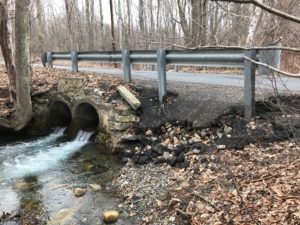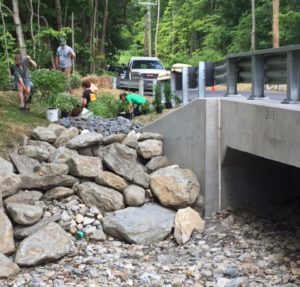
Especially to all creatures that depend on rivers and streams, including invertebrates, fish, amphibians, reptiles, and mammals. Experts say the design and condition of stream crossings determine whether a river behaves naturally and whether wildlife can migrate freely. Crossings should be essentially “invisible” to fish and wildlife—they should maintain appropriate flow and substrate through the crossing and not constrict a stream.
Through the combined effects of dams and poorly designed stream crossings (certain culverts and bridges), we have fragmented rivers and streams and hindered wildlife dispersal throughout our watersheds. In many cases, even crossings that were once effective are now barriers because of river erosion or mechanical breakdown. Safe and stable stream crossings can accommodate wildlife and protect stream health while reducing expensive erosion and structural damage.
That takes us to the Churchill Brook culvert which crosses Hancock Road in Pittsfield. (brook ultimately drains into Onota Lake). The pipes appear to have been improperly installed or developed erosion problems and acted like dams. They were elevated and made it difficult, if not impossible for trout to pass through. Fish had to jump in order to get into them and because they are pipes, and not a natural passway, they had to swim through stronger, concentrated currents to get to the other sides and continue their spawning run. Not only that, the culvert was falling apart.
The new culvert is much wider, with a natural stream bottom so that fish and other animals can easily pass through. A neighbor was really pleased with the improvement because during heavy rains, his lawn became completely flooded and his house became an island, due to the previous pipe being too small.
The Housatonic Valley Association (HVA), with help from the Berkshire Environmental Action Team (BEAT) decided to do something about that. They applied for, and received, grants from the Natural Resources Damages Program (NRD) and the Massachusetts Environmental Trust (MET).
There are two projects going on there. The NRD grant paid for the culvert project which allows the fish passage and the second project, a MET grant, paid to plant the rain gardens on both sides of the road. (Readers may recall in a previous article that funding for MET grants come from the sale of special license plates).
There are numerous brook trout all the way up the stream and until now they couldn’t swim upstream past the culverts. That is all changed now and the fish can pass through. Clayton Davenport Trucking, Inc. did the culvert replacement work.
There is one more culvert a little further upstream which crosses Churchill Road and HVA already has a grant to do that project as well. Hopefully in a couple of years, when that project is completed, it will open Churchill Brook from Onota Lake all the way up to Pittsfield State Forest, enabling brook trout to travel without obstructions.
Incidentally, MassWildlife has listed this brook as one of the best habitats for brook trout because there is ample food and cold, clean water.
Biologists caution us to not underestimate the effect of culvert crossings. While culverts only cover small sections of any stream, their influence on fish and other aquatic species can be immense, especially when you consider the cumulative effects of many road crossings. Proper planning, design, and installation can protect roads while providing year-round fish passage and preserving healthy streams.
Also, we should keep in mind that in situations where fish passage is not a major concern, other aquatic species of concern such as such as mink, frogs, turtles, insects, crayfish, snails, etc. may use the culvert and will need to rely on natural streambed sediments in the culvert to aid their movement. It has also been recognized for some time that juvenile fish are very active throughout the year, moving upstream and downstream in response to a number of environmental factors.
The Berkshires are not alone with culvert problems. In a 2009 survey of culverts in a nearby Appalachian watershed, some 120 state‐owned culverts were surveyed using a fish passage assessment filter to determine the “passability” of each culvert. The results showed that 97% of surveyed culverts were classified as obstacles or complete barriers to trout dispersal. Some 33% of brook trout reproductive habitat, was isolated by culverts. The results indicate that standard culvert designs placed in streams with slopes exceeding 5% consistently produce trout dispersal barriers.
Although no comprehensive inventory of the number of culverts on fish-bearing streams in the United States is available, there is an estimated 1.4 million stream-road crossings.
So why is it important for fish and other critters to be able to pass through these culverts? Well, according to Scott D. Jackson, Department of Natural Resources Conservation, University of Massachusetts, Amherst in a paper done in 2003 entitled Ecological Considerations in the Design of River and Stream Crossings, such movements maintain gene flow among populations, helping to maintain genetic health. They may also represent movements of surplus animals from one population to another, perhaps one that could not support itself on its own reproduction. This supplementation of failing populations from “source” populations is referred to as “the rescue effect.” Finally, areas of appropriate habitat that may be temporarily vacant due to local extinctions, can be re-colonized by individuals from populations nearby.
The new rain gardens prevent much of the run-off (containing oil, gasoline and pollutants) which comes off the road from washing right into the brook and negatively affecting the water quality. The HVA/BEAT team built a buffer area so the water that comes into the drainage ditch is pooled in a vegetative garden which is submerged. It settles and filters the runoff gradually into the ground and replenishes the groundwater before entering the brook.
The type of vegetation planted were: Joe Pye Weed, sweet pepperbush, chokecherries, red dozier dogwood, elderberry and winterberry, all wetland plants that can withstand being inundated in water for a while. According to Denis Regan. Berkshire Director of HVA, this is a 4 -year old project because they couldn’t do it until the new culvert was finished.
On the day, of my visit, volunteers were working hard in the 80+ degree heat planting the vegetation. Volunteers included Jane Winn, Executive Director of BEAT, Elizabeth Orenstein, Erin Whitman (HVA intern for the summer) Denis Regan. Berkshire Director of HVA, Alison Dixon, HVA Berkshire Outreach Manager, Jen Evans, (BEAT intern for the summer), Jeff Turner and Sharon Siter.
While I was there, Pittsfield Conservation Agent Robert Van der Kar and Pittsfield Staff Environmental Engineer Tim Croce dropped by to inspect the project to ensure compliance with storm water rules. Later on, Robert sent the following message to the HVA and BEAT volunteers: “On behalf of the folks here at City Hall, I just wanted to say how proud and grateful we are to have such a wonderful and dedicated group of people who continually improve the environment and quality of life (all life) here in the City of Pittsfield. You all truly make this a better place. Thank you all very much for all of your time and hard work in making what is an exemplary project; one that we’ll be sure to point to for years to come. Thank you.”
Berkshire Outdoorsman
Hunting and fishing in the Berkshires, MA
